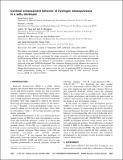| dc.contributor.author | Nam, Sung-Wook | |
| dc.contributor.author | Rooks, Michael J. | |
| dc.contributor.author | Yang, Joel K. W. | |
| dc.contributor.author | Berggren, Karl K. | |
| dc.contributor.author | Kim, Hyun-Mi | |
| dc.contributor.author | Lee, Min-Hyun | |
| dc.contributor.author | Kim, Ki-Bum | |
| dc.contributor.author | Sim, Jae Hwan | |
| dc.contributor.author | Yoon, Do Yeung | |
| dc.date.accessioned | 2012-10-19T14:13:58Z | |
| dc.date.available | 2012-10-19T14:13:58Z | |
| dc.date.issued | 2009-12 | |
| dc.identifier.issn | 1071-1023 | |
| dc.identifier.issn | 1520-8567 | |
| dc.identifier.uri | http://hdl.handle.net/1721.1/74146 | |
| dc.description.abstract | The authors investigated a contrast enhancement behavior of hydrogen silsesquioxane (HSQ) in a salty development system (NaOH/NaCl). Time-resolved analysis of contrast curves and line-grating patterns were carried out to investigate the unique properties of a salty development process. In NaOH developer without salt, the development process was saturated beyond a certain development time. On the other hand, the addition of salt enabled a continuous development, which was not observed in the pure NaOH development. The continuous thinning process enhances the contrast of HSQ in the salty developer, which allows a fast collapsing behavior in HSQ line-grating patterns. During development process, salt seems to have the role of modifying HSQ by breaking network bonds preferentially, leading to a continuous development rate. | en_US |
| dc.language.iso | en_US | |
| dc.publisher | American Vacuum Society (AVS) | en_US |
| dc.relation.isversionof | http://dx.doi.org/10.1116/1.3245991 | en_US |
| dc.rights | Article is made available in accordance with the publisher's policy and may be subject to US copyright law. Please refer to the publisher's site for terms of use. | en_US |
| dc.source | MIT web domain | en_US |
| dc.title | Contrast enhancement behavior of hydrogen silsesquioxane in a salty developer | en_US |
| dc.type | Article | en_US |
| dc.identifier.citation | Nam, Sung-Wook et al. “Contrast Enhancement Behavior of Hydrogen Silsesquioxane in a Salty Developer.” Journal of Vacuum Science & Technology B: Microelectronics and Nanometer Structures 27.6 (2009): 2635. © 2009 American Vacuum Society | en_US |
| dc.contributor.department | Massachusetts Institute of Technology. Department of Electrical Engineering and Computer Science | en_US |
| dc.contributor.department | Massachusetts Institute of Technology. Department of Electrical Engineering and Computer Science | en_US |
| dc.contributor.mitauthor | Yang, Joel K. W. | |
| dc.contributor.mitauthor | Berggren, Karl K. | |
| dc.relation.journal | Journal of Vacuum Science and Technology B Microelectronics and Nanometer Structures | en_US |
| dc.eprint.version | Final published version | en_US |
| dc.type.uri | http://purl.org/eprint/type/JournalArticle | en_US |
| eprint.status | http://purl.org/eprint/status/PeerReviewed | en_US |
| dspace.orderedauthors | Nam, Sung-Wook; Rooks, Michael J.; Yang, Joel K. W.; Berggren, Karl K.; Kim, Hyun-Mi; Lee, Min-Hyun; Kim, Ki-Bum; Sim, Jae Hwan; Yoon, Do Yeung | en |
| dc.identifier.orcid | https://orcid.org/0000-0001-7453-9031 | |
| mit.license | PUBLISHER_POLICY | en_US |
| mit.metadata.status | Complete | |
